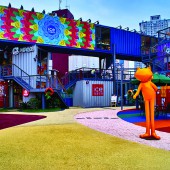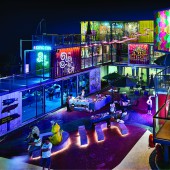Changsha Din Din Creativity Centre Architecture-commercial/Community by Atelier Global Limited |
Home > Winners > #55822 |
 |
|
||||
| DESIGN DETAILS | |||||
| DESIGN NAME: Changsha Din Din Creativity Centre PRIMARY FUNCTION: Architecture-commerc INSPIRATION: To build an“art market”in fast pace and express the casual nature of the program,recycled containers are used as architectural canvases for creative expression. Exterior skin of the recycled containers are painted and polished by the tenants and public, they are welcome to draw on the containers. Din Din the yellow cat is the icon of the center, they appear without any facial features, children are invited to draw the features to give them different faces everyday. The centre is all about public participation. UNIQUE PROPERTIES / PROJECT DESCRIPTION: A system of organic open spaces was meticulously crafted by fast erection of 27 recycled containers, to produce a seemingly casual nomadic market. Like building a nomadic village, the containers are causally positioned and stacked in three-storey, spaces inside the containers are partitioned into rooms for various workshops and sales points for pop art and designer items, light food and beverage. OPERATION / FLOW / INTERACTION: (1) Interactive Circulation Path:Terraces are from after the stacking of containers. External steel staircases are used to connect different floors. An unconventional circulation pattern ensures that visitors are guided not only along corridors but leaded inside container rooms throughout different floors, this pattern escapes from explicit planning logic of typical corridor in front of a room, and fuses the realms of private and public and encourages intimate encounters between visitors and designers. (2) public participation: The exterior skin of the containers are painted and polished by the public and shop owners, they are welcome to draw on the containers to express idea. Din Din the yellow cat is the icon of the centre, they appear without any face features, and children are invited to draw the eyes and mouths on their face to express their mood. It is all about participation. PROJECT DURATION AND LOCATION: Design started in June 2015 and construction finished in September 2015, intended to run for two year. FITS BEST INTO CATEGORY: Architecture, Building and Structure Design |
PRODUCTION / REALIZATION TECHNOLOGY: (1) The supporting system to stack the containers is corner steel posts and horizontal spacers, maximum structural span ensured. As a result, all structural components are very slim. When two containers are stacked up, the floor depth in between is just about 400mm, appeared as thin floor “separation”. Taking advantage of the slim quality of the elements and thin container floor slab, indoor activates at all levels are highly visible to the outdoor. The short visual distances between the container workshops make the activities at multi levels more transparent to the outside, and purposefully established a cozy and familiar environment, and encourage more human interactions. (2) Recycle material: Not only are the containers acquired from recycled site, the entire project is reusable. Standard size building materials e.g. steel staircases, balustrades, ground paving gravels are reused, recycled oil cans are used as outdoor luminaries and planter boxed. The act allows the client to move the containers and other building materials to another site later. SPECIFICATIONS / TECHNICAL PROPERTIES: Standard size recycle containers TAGS: recycle, public participation, interaction, container, floating tectonic RESEARCH ABSTRACT: N/A CHALLENGE: (1) Floating tectonic system: since only 2 months were allow for construction, apart from choosing container as building major material, the project transformed the perception of conventional regularity and vertical stacking of containers to floating tectonic system with enhanced transparency for interactions. Old containers in standard size 6m and 12m are used. Some rooms are combined by 2 or 3 containers in order to make wider space, some rooms only in a single narrow container, particularly those on higher floors. Placed and stacked in all directions, 2 large open space/squares are formed near the clusters. (2) Customization: Rooms on upper levels are standalone container of 2.5m wide, with a full-height window, the massing of these containers are greatly reduced. It gives high transparency to indoor and outdoor connection. ADDED DATE: 2017-02-28 15:14:10 TEAM MEMBERS (4) : Frankie Lui,, CC Law,, Xiafei Li, and Hongzia Wang IMAGE CREDITS: Atelier Global Limited , 2016. PATENTS/COPYRIGHTS: Copyright © 2013-10 Atelier Global All Rights Reserved |
||||
| Visit the following page to learn more: http://www.atelier-global.com/cn/product |
|||||
| AWARD DETAILS | |
 |
Changsha Din Din Creativity Centre Architecture-commerc · Read the interview with designer Atelier Global Limited for design Changsha Din Din Creativity Centre here. |
| SOCIAL |
| + Add to Likes / Favorites | Send to My Email | Comment | Testimonials | View Press-Release | Press Kit |
Did you like Atelier Global Limited's Architecture Design?
You will most likely enjoy other award winning architecture design as well.
Click here to view more Award Winning Architecture Design.








